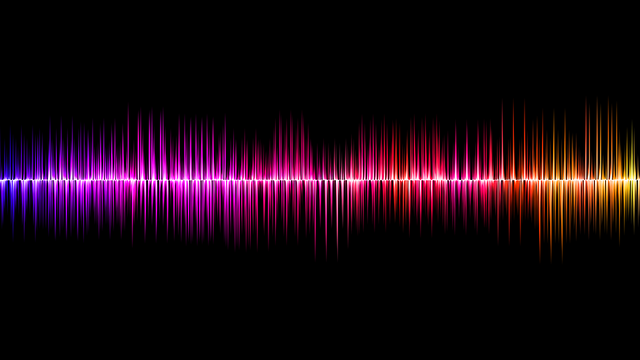Shaman Knowledge: The 4 types of sound in Nada-Yoga / Schamanenwissen: Die 4 Arten von Klang im Nada-Yoga
English - German
In this article, I will explain the 4 types of sound that are used in different yoga styles. With the help of links to previous articles, this opens up new applications and helps to better understand the knowledge of sounds.
- The rough sound
- The mental sound
- The visualized sound
- The transcendent sound

The rough sound
Whenever atoms meet or move, the coarse sound that is perceptible to us as an audible sound is created. Our ear can locate and classify the range from about 20 Hz to 18000 Hz, which is about 10 octaves, with great accuracy. In contrast, the eye stands with a perception width of only 1 octave, the range of visible light. From the animal kingdom we know much larger areas of perception, e.g. Elephants can locate frequencies of even under one hertz, generated by their feet, and communicate over long distances. Or the bat, which makes its detection by means of ultrasound. This audible rough sound is used with singing or reciting in the various yoga styles, e.g. to stimulate the organs.

The mental sound
This spiritual, mind-or-thinking sound is created by quietly repeating mantras, reading or whispering. The speech organs are used mentally without going through the entire processes of sound production. I have already presented a mantra in great detail, So-Ham.

The visualized sound
This sound, for example, appears in dreams in which we speak directly, of course without speaking. Our consciousness visualizes the conversations and noises in dreams. In lucid dreaming we use this possibility to guide dreams. Mantras can also be represented as symbols, so-called Yantras, which are then perceived by our consciousness as a mantra. This kind of sound is connected to the inner ear.

The transcendent sound
This sound is on the other side of everything imaginable, so to speak the all-embracing consciousness or the soul. In the yoga tradition, the mantra OM is the first word that contains everything. It represents the original sound of creation and is also considered the essence of the Veda. In my articles I have already presented several techniques of the Om: 1, 2. Both techniques can help you to further understand the meaning of this sound.

Im vorliegenden Artikel werde ich die 4 Arten von Klang erklären, die in verschiedenen Yoga Stilen von Beteutung sind. Mit Hilfe von Links zu früheren Artikeln erschließen sich dadurch neue Anwendungen und helfen das Wissen um Klänge besser zu verstehen.
- Der grobe Klang
- Der mentale Klang
- Der visualisierte Klang
- Der transzendierte Klang

Der grobe Klang
Immer wenn Atome aufeinander treffen oder sich bewegen entsteht der grobe Klang, der für uns Menschen als hörbarer Klang wahrnehmbar ist. Unser Ohr kann den Bereich von etwa 20 Hz bis 18000 Hz, das entspricht etwa 10 Oktaven, mit sehr großer Genauigkeit orten und einordnen. Dazu im Gegensatz steht das Auge mit einer Wahrnehmungsbreite von nur 1 Oktave, dem Bereich des sichtbaren Lichtes. Aus dem Tierreich kennen wir wesentlich größere Wahrnehmungsbereiche, z.B. Elefanten können Frequenzen von sogar unter einem Hertz, erzeugt mit den Füßen, genau orten und sich über große Distanzen verständigen. Oder die Fledermaus, die mittels Ultraschall ihre Ortung vornimmt. Dieser hörbare grobe Klang wird mit singen oder rezitieren in den verschiedenen Yoga Stilen eingesetzt um z.B. die Organe anzuregen.

Der mentale Klang
Dieser geistige, dem Geist oder dem Denken betreffende Klang entsteht beim stillen Wiederholen von Mantren, beim Lesen oder beim Flüstern. Dabei werden die Sprechorgane gedanklich benutzt ohne die kompletten Abläufe der Klangerzeugung zu durchlaufen. Dazu habe ich bereits ein Mantra sehr ausführlich vorgestellt, So-Ham.

Der visualisierte Klang
Dieser Klang taucht zum Beispiel in Träumen auf, in denen wir direkt sprechen, natürlich ohne zu sprechen. Unser Bewußstsein visualisiert die Gespräche und Geräusche in Träumen. Beim luziden Träumen nutzen wir diese Möglichkeit um Träume zu lenken. Mantren könne auch als Symbole dargestellt werden, sogenannte Yantras, diese werden dann vom Bewußtsein als Mantra wahrgenommen. Diese Art von Klang ist mit dem inneren Ohr verbunden.

Der transzendierte Klang
Dieser Klang ist jenseitig von allem Vorstellbarem, sozusagen das allumfassende Bewußtsein oder die Seele. In der Yogatradition ist das Mantra OM das erste Wort, das alles in sich enthält. Es repräsentiert den Urklangs der Schöpfung und wird auch als die Essenz der Veda betrachtet. In meinen Artiklen habe ich mehrere Techniken des Om bereits vorgestellt: 1, 2. Beide Techniken können dir als Hilfestellung dienen um die Bedeutung dieses Klanges weiter zu verstehen.

See you next time! / Bis nächstes Mal!
Thank you for your attention! / Danke für Deine Aufmerksamkeit!
Original content by
 Schaman Gerbert
Schaman Gerbert
Aloha. Sehr schoener Artikel. Dazu fällt mir ein: Was ist Realität? Es existiert keine "allgemeine gültige Realität" Die Realität entsteht erst in unseren Gehirn und ist daher individuell. Für eine Fledermaus ist die Realität ganz anders, da ihre Wahrnehmung komplett anders ist. Für mich kann die Farbe Grün etwas anders sein als du sie siehst! Realität entsteht aus der Wahrnehmung verschiedener Schwindungen. Namaste
visualized sound for me. I hope i can try yoga sometimes captain @schamangerbert . Thanks for sharing this 👍❤️❤️❤️
Thank you very much for such an interesting essential guide to sound and spirituality! You must have been an Indian mystic in your past life for you could understand the esoteric knowledge so readily as if you had known this already.
I will have to go back to listen to your previous videos again to refresh my memory.
This is very helpful in these days of pressures and disturbing energy.
Cheers.
Wow, das ist sogar neu für mich! Sehr interessant! Sound Nr. 2 ist für mich wie das Atmen. Mit einem Wort: immer! :)
Das ist nicht richtig, da du z.B. auch im Schlaf atmest. Oder stell dir vor du betrachtest ein Bild das so ähnlich wie ein Yantra Töne in dir hervorruft. Im Nada-Yoga sind diese Unterschiede sehr wichtig.
Schlaf ist natürlich abzuziehen, weil da habe ich ja keine Kontrolle. Gemeint ist im Wachzustand, auch nachts, denn ich bin auch of nachtaktiv. Ein Bild ruft Yantra-Töne hervor? Dann wohl auch Musik oder das Betrachten von Pflanzen? Die Bezeichnng ist mir neu. Da schließt nach Yoga-Lehre das Eine das Andere also aus? Gibt's Lektüre dazu?
ohhhhhh thanks for sharing some great techniques and knowledge. appreciate about it. Today i learn many new things from you , it's a pleasure keep posting like that . I'm always here to support you .
The first time I went to India, little did I know that my life was going to completely change.
I know, many people come back from India saying they transformed. It happened to me, too.
At that time, I was a singing student at the university in Montreal and was feeling blocked. My voice was weak and so was my morale.
I didn't know that yoga has different sound... i should learn yoga... 😊😊😊😘 this is very informative captain, thank you😘😘😘
Sometimes we all need a little inspiration to guide our lives, our thoughts, our yoga and meditation practice.
The gift of learning to meditate is the greatest gift you can give yourself in this lifetime.
Thank you @schamangerbert
All these four sounds make the experience even better and amazing wonderful post you shared today
👌👌👌👌👌👌👌👌👌